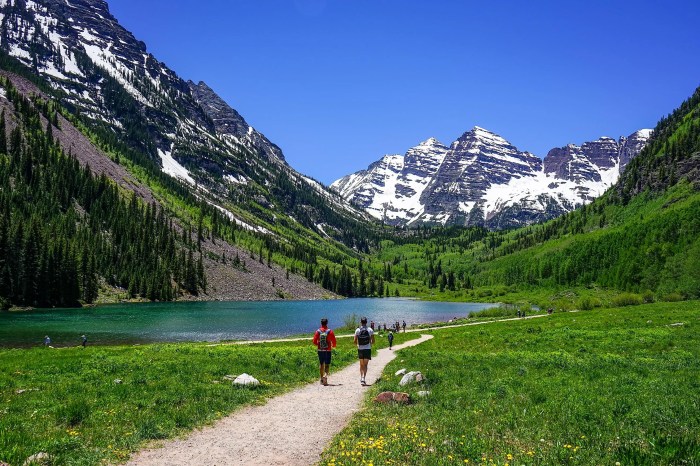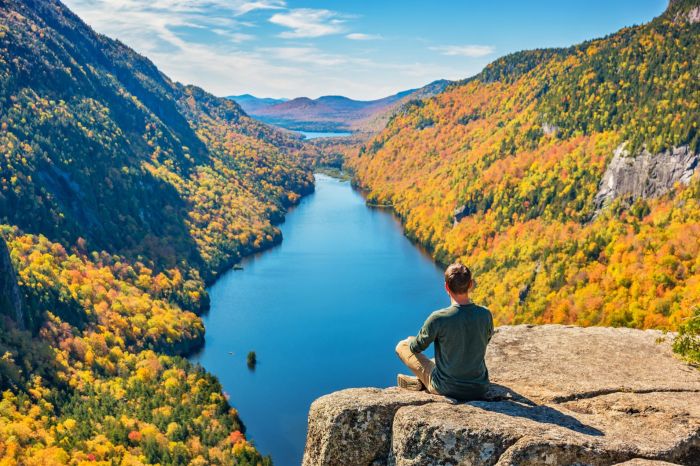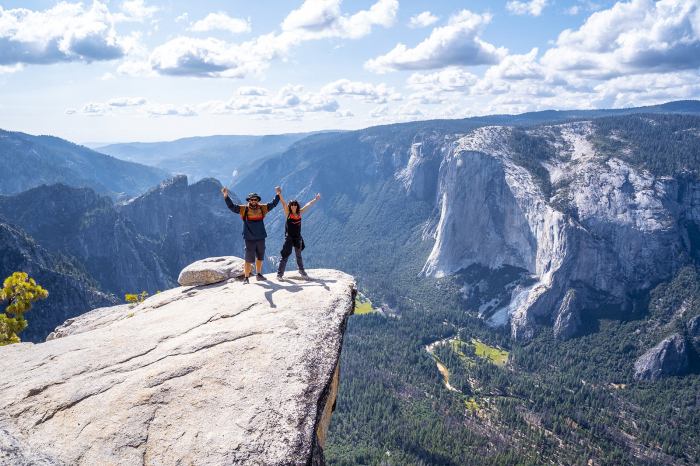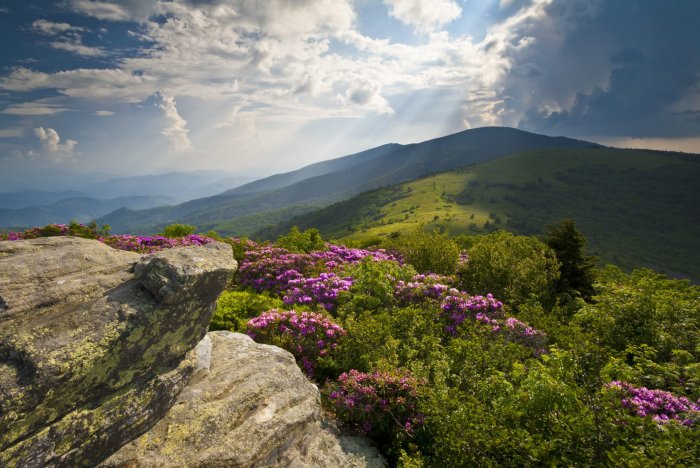Best hiking trails in the US – Embark on an unforgettable journey through the breathtaking landscapes of the United States, where nature’s wonders await exploration on the best hiking trails in the country. From novice wanderers to seasoned adventurers, there’s a trail tailored to every skill level, promising an immersive experience amidst pristine wilderness.
As you traverse these iconic paths, marvel at the diverse ecosystems, encounter captivating wildlife, and uncover the rich history that has shaped these natural treasures. Let the allure of the great outdoors captivate your senses as you forge lasting memories on the best hiking trails in the US.
Hiking Trails Overview

Hiking is an incredibly popular activity in the United States, with millions of people enjoying the beauty and challenges of the country’s many trails. There are hiking trails to suit all levels of experience, from easy day hikes to challenging multi-day backpacking trips. Some of the most famous hiking trails in the US include the Appalachian Trail, the Pacific Crest Trail, and the Continental Divide Trail.
Types of Hiking Trails
There are many different types of hiking trails available in the US, each with its own unique set of challenges and rewards. Some of the most common types of hiking trails include:
- Day hikes: Day hikes are typically shorter trails that can be completed in a single day. They are a great way to get some exercise and enjoy the outdoors without having to commit to a longer trip.
- Backpacking trips: Backpacking trips are longer hikes that require you to carry all of your gear with you. They can last for several days or even weeks, and they offer a great way to experience the wilderness up close.
- Loop trails: Loop trails are trails that start and end at the same place. They are a good option for day hikes or short backpacking trips, as you don’t have to worry about arranging transportation back to your starting point.
- Point-to-point trails: Point-to-point trails are trails that start and end at different locations. They are often longer than loop trails, and they require you to arrange transportation between the trailheads.
Famous Hiking Trails
There are many famous hiking trails in the US, each with its own unique history and character. Some of the most popular hiking trails include:
- Appalachian Trail: The Appalachian Trail is a 2,190-mile trail that runs from Georgia to Maine. It is one of the most popular hiking trails in the US, and it offers a challenging but rewarding experience.
- Pacific Crest Trail: The Pacific Crest Trail is a 2,650-mile trail that runs from California to Washington. It is another very popular hiking trail, and it offers stunning views of the Pacific Ocean and the Sierra Nevada mountains.
- Continental Divide Trail: The Continental Divide Trail is a 3,100-mile trail that runs along the Continental Divide from Mexico to Canada. It is the longest hiking trail in the US, and it offers a challenging but rewarding experience.
Trail Difficulty Levels
Before embarking on a hiking adventure, it’s crucial to assess the difficulty level of the trail to ensure it aligns with your fitness level and experience. Trails are typically categorized into three primary difficulty levels: easy, moderate, and difficult.
Determining Trail Difficulty
Several factors contribute to the difficulty rating of a trail, including:
- Distance: Longer trails tend to be more challenging.
- Elevation gain: Trails with significant elevation gain require more physical effort.
- Terrain: Rocky, uneven, or muddy terrain can increase the difficulty.
- Obstacles: Trails with obstacles such as fallen trees or water crossings can pose additional challenges.
- Exposure: Trails with exposed sections may require scrambling or the use of ropes.
Trail Difficulty Examples
Easy Trails
Easy trails are suitable for hikers of all ages and fitness levels. They typically feature:
- Short distances (less than 5 miles)
- Minimal elevation gain
- Well-maintained trails with few obstacles
- Example: Bridalveil Fall Trail in Yosemite National Park
Moderate Trails
Moderate trails offer a greater challenge while remaining accessible to hikers with average fitness. They typically involve:
- Distances ranging from 5 to 10 miles
- Moderate elevation gain
- Some technical sections, such as uneven terrain or small stream crossings
- Example: Angels Landing Trail in Zion National Park
Difficult Trails
Difficult trails are designed for experienced hikers and require a high level of physical fitness and technical skill. They often feature:
- Distances exceeding 10 miles
- Significant elevation gain
- Technical terrain with obstacles such as rock scrambling or water crossings
- Example: Half Dome Trail in Yosemite National Park
Trail Locations: Best Hiking Trails In The US

The United States is a vast and diverse country, with an incredible array of hiking trails to explore. From the towering peaks of the Rocky Mountains to the lush forests of the Pacific Northwest, there’s a trail for every level of hiker.
Here are some of the top hiking destinations in the US:
National Parks
National parks are home to some of the most iconic hiking trails in the country. These trails offer a chance to experience the beauty of nature up close, and to see some of the most amazing landscapes in the world.
- Yosemite National Park, California: Home to Half Dome, El Capitan, and other iconic peaks, Yosemite offers a variety of trails for all levels of hikers.
- Grand Canyon National Park, Arizona: The Grand Canyon is one of the most popular hiking destinations in the world, with trails that range from easy day hikes to challenging multi-day treks.
- Zion National Park, Utah: Zion is known for its towering sandstone cliffs and narrow canyons, and offers a variety of hiking trails that explore this unique landscape.
- Acadia National Park, Maine: Acadia is home to Mount Desert Island, which offers a variety of hiking trails that lead to stunning views of the Atlantic Ocean.
- Great Smoky Mountains National Park, North Carolina and Tennessee: The Great Smoky Mountains are home to a diverse range of plant and animal life, and offer a variety of hiking trails that explore this beautiful landscape.
Trail Features
Beyond the physical challenge and breathtaking scenery, hiking trails offer a myriad of features that enhance the overall experience. These elements, ranging from diverse wildlife encounters to historical landmarks, contribute to the uniqueness and appeal of each trail.
The allure of a trail lies not only in its scenic beauty but also in the encounters with the local fauna. Trails that traverse through national parks and wildlife sanctuaries provide opportunities to observe a wide range of animals in their natural habitat. From majestic birds soaring overhead to elusive mammals roaming the undergrowth, these encounters add a touch of excitement and wonder to the hike.
Wildlife
- Denali National Park and Preserve in Alaska offers hikers the chance to spot grizzly bears, moose, and wolves.
- Yellowstone National Park is renowned for its abundant wildlife, including bison, elk, and black bears.
- Grand Canyon National Park provides a habitat for California condors, bighorn sheep, and coyotes.
In addition to wildlife, many trails boast historical significance, offering a glimpse into the past. These trails may lead to ancient ruins, abandoned settlements, or battlefields, providing a deeper understanding of the region’s history and culture.
The United States boasts some of the world’s most breathtaking hiking trails, offering unparalleled natural beauty. From the iconic Appalachian Trail to the rugged Pacific Crest Trail, there’s a trail for every level of hiker. And if you’re looking for a cultural experience to complement your hiking adventure, be sure to check out some of the best cultural festivals worldwide.
These festivals showcase the rich traditions and vibrant cultures of different regions, making them a great way to learn about new perspectives and connect with people from all walks of life. After immersing yourself in the vibrant cultural tapestry of the world, you can return to the serene beauty of the US hiking trails, where you can find solace in nature’s embrace.
Historical Significance
- The Appalachian Trail passes through several historic sites, including the Appalachian Trail Conservancy headquarters and the Delaware Water Gap National Recreation Area.
- The Pacific Crest Trail follows the footsteps of early explorers and pioneers, passing through historic mining towns and logging camps.
- The Continental Divide Trail traverses the Rocky Mountains, offering hikers a chance to explore the historic mining and railroad towns that shaped the region.
Trail Amenities

Hiking trails can offer a variety of amenities to enhance the experience for hikers. These amenities can range from basic necessities like restrooms and water sources to more elaborate features such as shelters, picnic areas, and scenic overlooks.
Amenities can play a crucial role in making a hike more enjoyable and safe. Restrooms, for example, provide a convenient and sanitary way for hikers to relieve themselves, while water sources allow them to replenish their supply and stay hydrated. Shelters offer protection from the elements, providing a place to rest, eat, or seek refuge in case of bad weather.
Restrooms
- Provide a convenient and sanitary way to relieve oneself
- Can be found at trailheads, along the trail, or at designated rest areas
- May be pit toilets, vault toilets, or composting toilets
Water Sources
- Allow hikers to replenish their water supply and stay hydrated
- Can be found at trailheads, along the trail, or at designated water sources
- May be natural springs, streams, or wells
Shelters
- Provide protection from the elements, a place to rest, eat, or seek refuge in case of bad weather
- Can be found at trailheads, along the trail, or at designated campsites
- May be open-air shelters, lean-tos, or cabins
Trail Safety

Hiking is a fantastic way to enjoy the outdoors, but it’s important to remember that safety should always be your top priority. Potential hazards can lurk on any trail, so it’s essential to be aware of them and take steps to avoid them.
Here are some tips for staying safe on the trail:
Know the Trail
Before you start hiking, take some time to research the trail you plan to hike. This will help you understand the difficulty level, length, and any potential hazards. You can find trail information online, in guidebooks, or at the trailhead.
Planning a hiking adventure in the US? Don’t forget to consider your travel budget. Use our travel budget calculator to estimate expenses and ensure a worry-free journey. Once you have a budget in place, you can explore the stunning hiking trails that the US has to offer, from the majestic mountains of the Rockies to the lush forests of the Pacific Northwest.
Tell Someone Your Plans
Before you go hiking, let someone know where you’re going and when you expect to be back. This way, if something happens, someone will know where to look for you.
Stay on the Trail
It’s tempting to wander off the trail, but it’s important to stay on it for your safety. Staying on the trail helps prevent you from getting lost or injured. It also helps protect the environment.
Be Aware of Your Surroundings
Pay attention to your surroundings while you’re hiking. Be aware of the weather, the terrain, and any other hikers or animals in the area. This will help you avoid potential hazards.
Carry Essential Gear, Best hiking trails in the US
When you’re hiking, always carry essential gear, such as a map, compass, flashlight, first-aid kit, and plenty of water. This gear will help you stay safe in case of an emergency.
Be Prepared for the Weather
The weather can change quickly in the mountains, so it’s important to be prepared for anything. Bring layers of clothing, including a raincoat and hat. Also, check the weather forecast before you go hiking.
Respect Wildlife
Wildlife is an important part of the hiking experience, but it’s important to respect it. Give animals plenty of space and never approach them. If you see a bear, mountain lion, or other large animal, make yourself look big and back away slowly.
Be Aware of Poisonous Plants
There are many poisonous plants in the mountains, so it’s important to be aware of them. Learn how to identify them and avoid touching them. If you do come into contact with a poisonous plant, wash the area with soap and water and seek medical attention if necessary.
Trail Etiquette

When embarking on a hiking adventure, it’s crucial to adhere to proper trail etiquette to ensure a harmonious and respectful experience for all. Responsible hiking practices not only enhance the enjoyment of your journey but also protect the delicate ecosystems you traverse.
The US boasts some of the world’s most breathtaking hiking trails, offering a perfect blend of adventure and natural beauty. However, when it comes to planning a family vacation, finding destinations that cater to both parents and children can be a challenge.
To make the most of your family time, consider exploring some of the best family vacation spots that also feature exceptional hiking trails. This way, you can enjoy the great outdoors while creating lasting memories with your loved ones.
Respecting Others
Trails are shared spaces, so it’s essential to be considerate of other hikers. Avoid loud noises, stay on designated paths to prevent erosion, and yield to those passing in either direction. When encountering others, offer a friendly greeting and make way for them to pass.
Protecting the Environment
Hiking trails often lead through pristine natural environments. To preserve these delicate ecosystems, it’s imperative to pack out everything you pack in, including trash and food scraps. Avoid disturbing plants and wildlife, and stay on marked trails to minimize your impact.
Proper Trail Behavior
Follow these guidelines for responsible trail behavior:
- Stay on designated trails to prevent erosion and protect vegetation.
- Yield to hikers moving uphill, as it requires more effort.
- Keep dogs on a leash to prevent disturbances and potential conflicts.
- Avoid using loud or offensive language that may disrupt others.
- Be mindful of your surroundings and yield to wildlife.
Trail Resources

Planning and preparing for a hiking trip requires access to reliable information about trails. Fortunately, hikers have a wide range of resources available to help them make informed decisions and ensure a safe and enjoyable experience.
Websites, apps, and guidebooks provide detailed trail information, including descriptions, maps, elevation profiles, and reviews. These resources can help hikers choose trails that match their fitness level, interests, and time constraints.
Websites
- AllTrails: A comprehensive website and app that provides information on over 100,000 trails worldwide.
- HikingProject: Another popular website and app with a vast database of trails, including detailed descriptions, maps, and user reviews.
- National Park Service: The official website of the National Park Service provides information on trails in all national parks and monuments.
Apps
- Gaia GPS: A paid app that offers offline maps, GPS tracking, and the ability to create custom waypoints and routes.
- Avenza Maps: Another paid app that allows users to download maps and track their location even without a cellular signal.
- Maprika: A free app that provides access to topographic maps and allows users to create and share custom maps.
Guidebooks
- FalconGuides: A publisher that produces a wide range of hiking guidebooks for specific regions and trails.
- National Geographic: Another publisher that offers a variety of hiking guidebooks, including both general overviews and trail-specific guides.
- Mountaineers Books: A publisher specializing in outdoor recreation guidebooks, including hiking, climbing, and skiing.
Final Wrap-Up
![]()
Whether you seek a leisurely stroll through verdant forests or an exhilarating ascent to breathtaking summits, the best hiking trails in the US offer an unparalleled adventure. Embrace the tranquility of nature, challenge your limits, and discover the boundless beauty that awaits on these extraordinary trails.
Detailed FAQs
What are the most popular hiking trails in the US?
Some of the most popular hiking trails in the US include the Appalachian Trail, the Pacific Crest Trail, and the Continental Divide Trail.
How can I determine the difficulty of a hiking trail?
The difficulty of a hiking trail is typically determined by factors such as elevation gain, distance, and terrain. Trails are often rated on a scale from easy to difficult.
What are some tips for staying safe on a hiking trail?
Some tips for staying safe on a hiking trail include being prepared with proper gear, informing someone of your itinerary, and staying on designated trails.